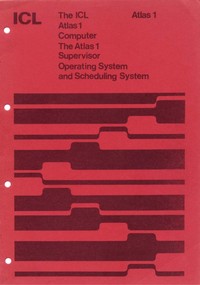The ICL Atlas 1 Computer and the Atlas Supervisor Operating System and Scheduling System
| Home > Browse Our Collection > Manuals > Ferranti > The ICL Atlas 1 Compu ... and Scheduling System |
|
The design of Atlas was one of the many achievements of the distinguished team of computer scientists and engineers at the University of Manchester headed by Dr Tom Kilburn-now Professor Kilburn FRS. It was developed over the period 1957-1961 and was aimed at producing a large-scale computer which had high basic speed (i.e. would do elementary mathematical operations such as add or multiply very quickly) and which had also very powerful, flexible and largely automatic means for organising and controlling the flow of work through it. This function was performed by a large and complex master program which resided in the machine permanently, a design feature that was very advanced in 1960 but which is now standard in virtually all but the smallest computers.
The current name for this kind of master program is the Operating System-the Manchester group called this the Supervisor and the Atlas Supervisor was far more comprehensive and ambitious than anything else in existence or being considered commercially at the time. It is probably true to say that Atlas was the first computer to have an operating system in the modern sense of the term. The Atlas design included other novel and advanced features, many of which have now become part of the general body of computer technology. The most important of these, the paged store, has proved to be an idea with far-reaching consequences. Basically it is a means of organising the computer store, with the aid of special hardware registers, so that the operating system can allocate storage to programs and data, and can move these around in the store in a very free and flexible way, to suit the demands being made on the machine at any time. In particular it allows blocks of information (program or data) to be transferred between the fast expensive main store and the cheaper large-capacity backing store, i.e. to devices such as magnetic drums or discs, without any need for the programmer to plan this; the effect is that the programmer can regard the store as a continuous whole, of very large capacity, and need not concern himself with its actual division say into core, drums, and discs in the real machine. This concept was called the "one-level store" by Manchester; it is tending now to be described as "virtual store" or "virtual memory".
This manual has very kindly been donated by Chris Eva.
This exhibit has a reference ID of CH3660. Please quote this reference ID in any communication with the Centre for Computing History. |
Click on the Images For Detail
|










